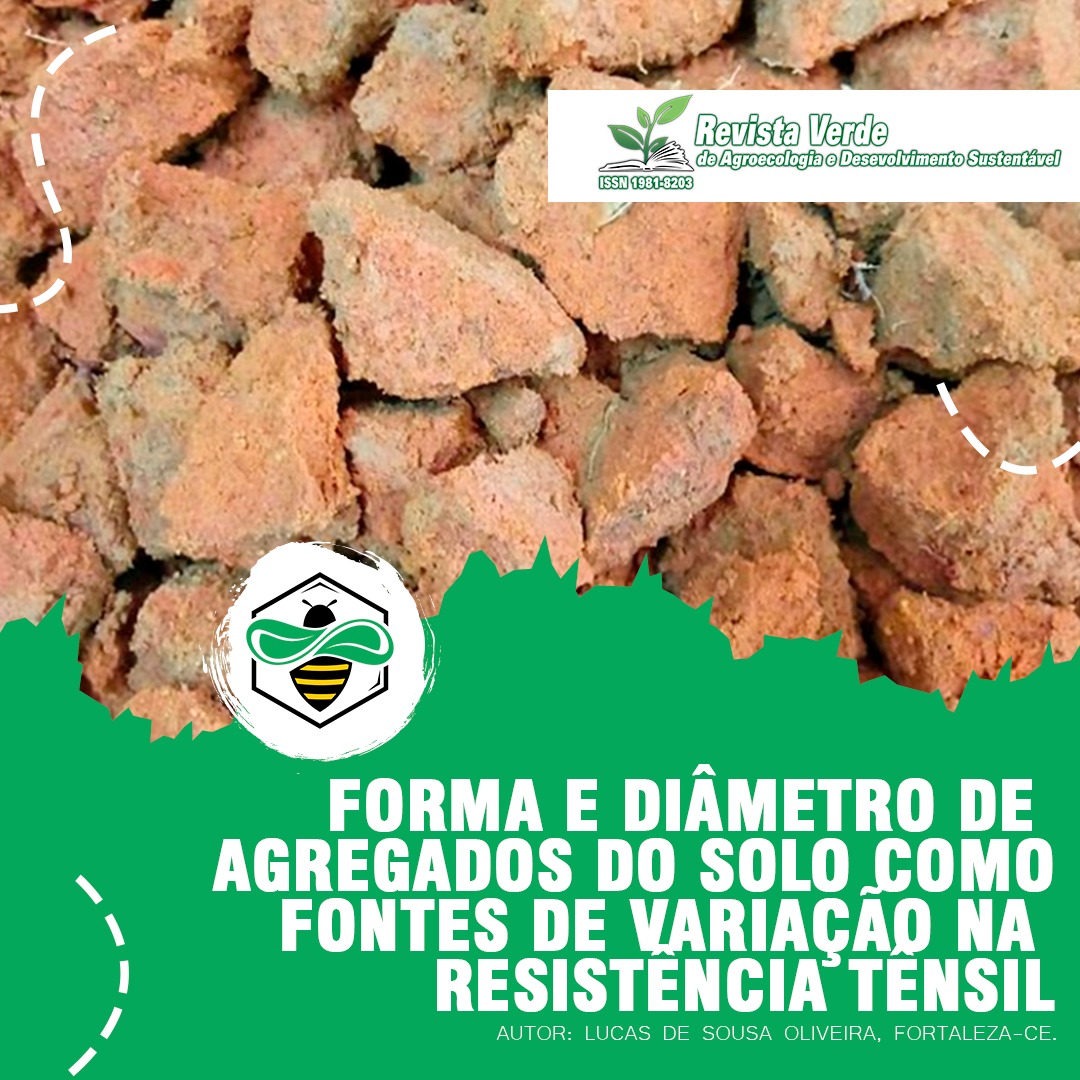Shape and diameter of soil aggregates as sources of variation in tensile strength
DOI:
https://doi.org/10.18378/rvads.v16i1.7825Keywords:
Soil structure, Soil physics, Soil qualityAbstract
Soil quality is essential to ensure the sustainability of agro-ecosystems. Tensile strength is one of the indicators frequently used for monitoring soil quality, being influenced by several factors, such as the size and shape of the aggregate. In this research, the hypothesis that the use of a single form of soil aggregates reduces the variability in the evaluation of the structural quality of soils was considered. In addition, the size of the aggregates influences the determination of tensile strength. Thus, the objective was to evaluate the relationship of tensile strength with the size and shapes that aggregates can assume. Two aggregate diameter bands (25-19 and 19-7.96 mm) and three aggregate forms (irregular, planed and spherical bases) were used. The aggregates with smaller diameters (13.5 mm) presented the highest mean values of tensile strength (82.73 kPa). The tensile strength determined in spherical aggregates showed less variability. For these aggregates, the coefficient of variation of the tensile strength was 29.30 and 19.29%, for the average diameters of 22 and 13.5 mm, respectively. As a result, shape must be considered when assessing the tensile strength of the soil aggregate.
Downloads
References
BARBOSA, L. A. P.; FERRAZ, A. C. O. Which evidence attests for soil aggregate rupture? A new criterion to determine aggregates tensile strength. Soil and Tillage Research, v. 197, n. 104530, p. 1-9, 2020. 10.1016/j.still.2019.104530.
CABELL, J. F.; OELOFSE, M. An Indicator Framework for Assessing Agroecosystem Resilience. Ecology and Society, v. 17, n. 1, p. 1–13, 2012. 10.5751/ES-04666-170118.
DEXTER, A. R.; KROESBERGEN, B. Methodology for determination of tensile strength of soil aggregates. Journal Agriculture Engineering Research, v. 31, p. 139-147, 1985. 10.1016/0021-8634(85)90066-6.
DEXTER, A.R.; WATTS, C.W. Tensile strength and friability. In: Soil Environment Analysis. Structural Methods, 2nd Ed. K.A Smith and C.E. Mullins (eds.). Marcel Dekker, New York, NY, pp. 401-430, 2000.
FERREIRA, D. F. Sisvar: A guide for its Bootstrap produces in multiple comparasions. Ciência e Agrotecnologia, v. 38, n. 38, p. 109-112, 2014. 10.1590/S1413-70542014000200001 .
FIGUEIREDO. C.; SILVA, A. P.; TORMENA, C. A.; GIAROLA, N. F. B; MORAES, S. O.; ALMEIDA, B. G. Desenvolvimento de um consolidômetro pneumático; modelagem da compactação, penetrometria e resistência tênsil de agregados de solo. Revista Brasileira de Ciência do Solo, v. 35, p. 389-409, 2011. 10.1590/S0100-06832011000200009 .
JONG VAN LIER, Q.; GUBIANI, P. I. Além do “intervalo hídrico ótimo”: Repensando a pesquisa em física do solo no Brasil. Revista Brasileira de Ciência do Solo, v. 9, p. 925-939, 2015.
LI, Y.; LI, Z.; CUI, S.; ZANG, Q. Trade-off between soil pH, bulk density and other soil physical properties under global no-tillage agriculture. Geoderma, v. 361, n. 114099, p. 1-9, 2020. 10.1016/j.geoderma.2019.114099.
MUNKHOLM, L. J. Soil friability: A review of the concept, assessment and effects of soil properties and management . Geoderma, v. 167, p. 236-246, 2015. 10.1016/j.geoderma.2011.08.005.
MUNKHOLM, L. J.; HECK, R. J.; DEEN, B.; ZIDAR, T. Relationship between soil aggregate strength, shape and porosity for soils under different long-term management. Geoderma, v. 268, p. 52–59, 2016. 10.1016/j.geoderma.2016.01.005.
OLIVEIRA, L. S.; MAIA, R. N.; ASSIS JÚNIOR, R. N.; ROMERO, R. E.; COSTA, M. C. G.; ALENCAR, T. L.; MOTA, J. C. A. Tensile strength values for degrees of soil consistency using human perception and TS-Soil device. Catena, v. 190, n. 104541, 2020. 10.1016/j.catena.2020.104541
RABOT, E.; WIESMEIER, M.; SCHÜTER, H.; VOGEL, J. Soil structure as an indicator of soil functions: A review. Geoderma, v. 314, p. 122-137, 2018. 10.1016/j.geoderma.2017.11.009.
SANTOS, H. G.; JACOMINE, P. K. T.; ANJOS, L. H. C.; OLIVEIRA, V. A. Sistema Brasileiro de Classificação de Solos. Empresa Brasileira de Pesquisa Agropecuária, Embrapa Solos. 5. ed. Brasília: Embrapa Solos, 2018. 590 p.
SEBEN Jr, G. F.; CORÁ, J. E.; FERNANDES, C.; LAL, R. Aggregate shape and tensile strength measurement. Soil Science, v. 178, p. 301-307, 2013. 10.1097/SS.0b013e3182a4a0a6.
STEFANOSKI, D. C.; SANTOS, G. G.; MARCHÃO, R. L.; PETTER, F. A.; PACHECO, L. P. Uso e manejo do solo e seus impactos sobre a qualidade física. Revista Brasileira de Engenharia Agrícola e Ambiental, v. 17, p. 1301-1309, 2013. 10.1590/s1415-43662013001200008.
TORMENA, C. A.; FIDALSKI, J.; ROSSI JUNIOR, W. Resistência tênsil e friabilidade de um Latossolo sob diferentes sistemas de uso. Revista Brasileira de Ciência do Solo, v. 32, p. 33-42, 2008. 10.1590/S0100-06832008000100004.
WARRICK, A. W.; NIELSEN, D. R. Spatial variability of soil physical properties in the field. In: HILLEL, D. (ed.) Applications of soil physics. New York, Academic Press, 1980. 350p.
XAVIER, C. A.; MOITINHO, M. R.; TEIXEIRA, D. B.; SANTOS, G. A. A.; BARBOSA, M. A.; MILORI, D. M. B. P.; RIGOBELO, E.; CORÁ, J. E.; LA ESCALA Jr, N. Crop rotation and sucession in a no-tillage system: Implications for CO2 emission and soil attributes. Journal Envrionmental Management, v. 245, p. 8-15, 2019. 10.1016/j.jenvman.2019.05.053.











